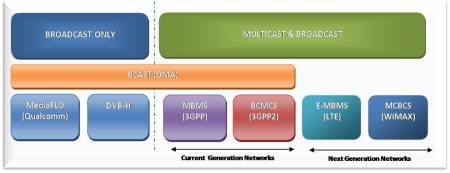With the evolution of Smartphone and exponentially growing market for high speed multimedia services the network needs to be smarter for delivering an exhilarating user-experience. .The transformation of mobile devices industry led by advent of successful smartphones such as Blackberry, Apple iPhone the users have become more data hungry and demanding more interactive services loading the mobile network operator’s network.Multicast and Broadcast services (MBS) is the solution that will not only cater this need efficiently but also attract a large subscriber base. MBS offers real time streaming services, audio-video on demand, multiplayer online gaming, localized services, news advertisements, stocks bringing the most anticipated services at your finger tips.
MBS in 3rd Generation and 4th Generation Wireless systems requires efficient network resource utilization in access and core networks along with scalable and reliable service platforms. Also, it should incorporate the mobility aspects to continuously deliver multimedia information over an efficient air interface.
The major MBS technologies used in various 3G/4G deployment models are Media FLO by Qualcomm, DVB-H (Digital Video Broadcasting-Handheld) by DVB, MBBS by 3GPP and BCMCS by3GPP2. These technologies have garnered much attention for the revenues they can bring to terminal suppliers, network equipment suppliers, mobile operators, broadcast operators, service providers and even governments.
The main analysis considering the different old as well as new evolving use cases with the MBS technologies supporting these different services can be mapped as follows:
Considering the above use-cases we can draw insights:
1. Selection: The selection of particular MBS technology by the mobile network operator should be based on following criteria
2. Cost: For heavy duty broadcast applications the resources required would be greater in a 3G network compared to a Broadcast only network such as MediaFLO or DVB-H and hence the cost.
Whereas for light applications and highly interactive applications MBMS or BCMCS would be the ideal choice saving on resources by multicasting to the subscribed group of users instead of broadcasting it to every user in the network. Also, due to availability of an uplink channel, highly interactive applications can be easily supported on the mobile terminal providing a better user experience. Also, from unicasting perspective, with Multicast usage there is a considerable resource savings in core network and radio access network where the radio bearers are lesser than number of users compared to the number of bearers which is equal to number of users in unicast transmissions
3.Reach: MediaFLO and DVB-H have a larger cell size and hence a larger footprint which again thus requires lesser base stations covering groups of subscriber services. But again due to the existing vast coverage of the 2G/3G cellular network, these base stations can be easily upgraded to MBMS/BCMCS capabilities with a comparatively greater reach though smaller individual footprint.
4. Interactivity: Broadcast only networks are limited due to the lack of backward channel and hence no interactivity. But the interactivity can be implemented by using network operator’s feedback channel.
5.Mobile Terminal: In the current scenario, for specific applications such as Live TV, broadcast only technologies like MediaFLO or DVB-H might prove to be more efficient but the downfall is the corresponding handsets should be available to receive such broadcasts so that is an additional cost to the MNO’s.
6.Business Implicaitons: The broadcast and multicast are complimentary technologies where broadcast can be used for stimulating users to subscribe to the services and multicast services are used to cater specific endusers which eventually subscribes t ospecific services which generate revenues for the operators.
7.Mobile Trend: There is a significant growing trend towards a large number of interactive applications with the advent of modile web due to the availability of smartphones with a larger form factor and advanced capabilities. So most of the NGN will be equipped with cutting edge resource efficient technologies supporting heavy duty streaming and at the same time supporting a higher level of interactivity and a richer user experience with a better continous data connectivity and seamless mobility
Thus with a strong MBS technology selection by the MNO and a lucrative business model a smart telecom value chain is possible and with higher order benefits.







 Posted by Neil Shah
Posted by Neil Shah 
